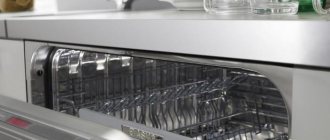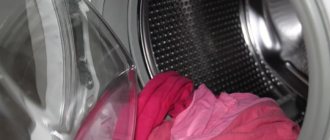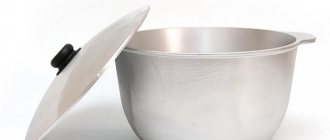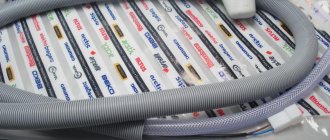How to load dishes into the dishwasher
Cleaning efficiency largely depends on how correctly you load all your plates, cups, cutlery, pans and pots into the dishwasher. If you neglect a number of recommendations regarding the placement of dishes in the dishwasher compartment, the result may not please you. In this case, you will sin not on yourself, but on your “helper”, and completely in vain...
All modern dishwashers, with the exception of super-compact models, are equipped with two baskets for dishes, as well as a tray for cutlery. The upper basket is designed for plates, cups, glasses, glasses and other relatively small items. If your dishwasher has an adjustable height for the upper basket, select its optimal position: water should evenly wet all loaded dishes.
Upper basket of the dishwasher.
The specialty of the lower basket of the dishwasher is pots, pans, baking sheets, large plates and dishes and other large items. In many models, the lower baskets are equipped with folding holders. When raised, these holders help distribute dishes evenly. But if there are too many dishes or the loaded utensils are very large, the holders can simply be folded - you will get a flat area for large items.
Lower basket of the dishwasher.
A cutlery tray is essentially a small removable basket in which spoons, forks, and cutlery are placed. Premium dishwashers often have an aluminum tray designed specifically for silver cutlery.
Removable basket for cutlery.
Tips for properly placing dishes in the dishwasher
Tip 1.
Before loading dishes into the machine, be sure to remove large pieces of food, bones, napkins, etc. from it. This will prevent the filter from becoming clogged during the cycle.
Tip 2.
To reduce energy consumption and at the same time improve the quality of the final result, pre-rinse especially dirty and greasy dishes with hot tap water. A stream of hot water will remove the heaviest dirt, thereby helping the machine cope with the task better and faster. This advice is especially relevant for owners of dishwashers that do not have a pre-soak mode.
Tip 3.
Place large items in the lower basket first, then small items in the upper basket.
Tip 4.
Plates, saucers, tureens are placed with the inside facing the center. Large plates should be placed in the peripheral parts of the basket, small ones - closer to the center. When placing plates in the holders, make sure that there is a small gap between them: if they are placed too close to each other, they may not be washed properly.
Tip 5.
Cups and glasses should be placed on special holders with their bottoms up to prevent water from accumulating in them. Fragile glasses made of crystal or thin glass should not come into contact with each other and with their “neighbors” in the basket, otherwise there is a high chance that after washing there will be more happiness in your home and fewer glasses.
Tip 6.
Place cutlery in the tray with the handles facing down - this will allow water to drain better from them.
Tip 7.
It is advisable to wash dirty dishes (pans, pots, baking sheets) separately from relatively clean plates and glasses. Try to place oven trays sideways in the dishwasher so that they do not impede the flow of water to the dishes on the upper level. But it’s better to turn pots and pans upside down.
Tip 8.
Do not overload the dishwasher! Do not stack dishes in it! Water must have free access to the surface of every pan, every plate, every glass, otherwise after washing you will still end up with dirty dishes. Be sure to make sure that the dishes loaded into the dishwasher do not interfere with the free movement of the rocker arms rotating around their axis, from which water sprays during the process.
Did you manage to load the dishes into the dishwasher? Now carefully inspect its contents again and make sure that everything placed there is allowed to be washed in dishwashers.
Idle start
Many PMM manufacturers recommend a dry start. This needs to be done for several reasons:
- During the first use, all debris and dust that may have settled on the parts are removed from the machine. In addition, a small amount of lubricant may remain on the main operating components of the equipment.
- During a test run, you can check the correct installation of the device and the correct execution of all processes (heating, water intake and draining).
- If certain problems are identified when you first turn it on, they can be corrected without laborious unloading of the dishes.
What can't be washed in the dishwasher
Almost everything can be washed in the dishwasher - from fragile glass glasses to frying pans and baking sheets. But there are exceptions to any rule: you can wash some items in the machine only once – the first and the last. Not every material can withstand a long stay in water, high temperatures, exposure to aggressive chemicals, or forced drying with hot air.
Let's figure out what dishes cannot be washed in the dishwasher, especially if the latter has a limited selection of washing modes.
Tree
If you don't plan on sending your favorite rolling pin or wooden spoon to the landfill anytime soon, refrain from putting it in the dishwasher. The result of this action is predictable. With prolonged contact with water, wood tends to swell - the fibers, saturated with moisture, increase in size.
Subsequent drying leads to a sharp compression of the wood fibers and, as a consequence, to the breaking of the strong bond between them. As a result, the wooden object is deformed, its surface becomes rough, cracks appear, in a word, the product loses its appearance.
Let us hasten to dissuade those who believe that nothing bad will happen in the short time the dishes are in the dishwasher chamber. In fact, the tree begins to swell after lying in cold water for only 30-40 minutes. What can we say about hot water, in which detergent is still dissolved... What do you think will happen to your wooden bowls, spoons, cutting boards, rolling pins, pancake spatulas that will be in such conditions for 2-3 hours?
Plastic
You can wash plastic in the dishwasher, but with one caveat - it must be heat-resistant (in this case, the product has a symbol that allows automatic washing).
However, it is not advisable to place dishes even made of heat-resistant plastic in the lower basket, i.e. near the heating element. Under no circumstances should there be disposable plastic cups, plates, spoons or forks in the car chamber.
Separately, I need to say a few words about vacuum-sealable dishes. Plastic containers, from under the lids of which air can be pumped out to create a vacuum inside, should also not be placed in the dishwasher. Even slight deformation of the plastic as a result of exposure to high temperatures will cause the vacuum container to lose its seal, and air will penetrate into it.
Porcelain
Do not auto-wash porcelain items, especially thin ones. Under the influence of hot water, porcelain can quickly become covered with a network of small cracks; turbo drying is completely destructive for this material. In addition, after several washes, the painting will fade if it is not protected by a layer of varnish. If you do decide to put porcelain in the dishwasher, select the “Delicate Wash” mode with a low temperature and a short cycle.
Crystal
Crystal is also not for those who like to take hot baths. He is afraid not so much of high temperatures as of their changes. As with porcelain, the “Delicate Wash” setting is recommended for crystal. It is better to wash especially valuable specimens by hand.
Noble and base metals
Automatic washing is contraindicated for products made of certain metals. For example, you should not load silver cutlery into the dishwasher: silver turns black from contact with some other metals (stainless steel, from which the inner walls of the chamber are made, is especially dangerous for it).
Under the influence of detergents, the surface of items made of silver, brass, tin, bronze becomes dull, and it can be very difficult to achieve the original shine.
Copper also does not tolerate prolonged exposure to hot water and detergent: in such aggressive conditions, copper objects tend to darken and lose their appearance.
Aluminum is a chemically very active metal, although in ordinary life we do not notice this due to the protective oxide film on its surface. However, sometimes this film is not able to protect against the effects of a solution of detergent in hot water: after being in the dishwasher, aluminum products often acquire a dark gray coating.
After the second or third wash in the dishwasher, cast iron cookware will become covered with a corrosive coating and lose its appearance.
Other
Sharp kitchen knives have no business in the dishwasher. Professionals wash their knives under running cool water because otherwise they will quickly become dull. If you practice washing kitchen knives in the dishwasher, you will have to sharpen them almost every day.
Do not put unglazed pottery and art objects in the dishwasher: microclay particles will quickly clog the filters.
If the manufacturer of your thermos or thermal mug has not provided its product with a machine washable symbol, you will have to manually polish it. Plastic items, the individual elements of which are connected with glue, also have no place in the dishwasher.
We tried, as best we could, to answer the question of what dishes should not be washed in the dishwasher. Of course, the full list of “prohibited” items and materials is much wider. But we hope you understand the principle and, therefore, will not make fatal mistakes.
Items not suitable for dishwasher
In the instructions for your dishwasher, you can find clear instructions about which items can be washed in the machine, which cannot, and which are possible, but not advisable. As a rule, the items in this list are relevant for any model. Here is something that is absolutely not suitable for PM:
- dishes with damage, obvious or hidden;
- wooden items, including knives with wooden handles, cutting boards and the like;
- items subject to rust. As a rule, these are dishes made of alloys based on copper and tin;
- glass and plastic dishes.
But the fact is that you can wash it in the dishwasher, but you shouldn’t abuse it unless absolutely necessary.
- silver and aluminum dishes;
- faience;
- crystal.
You can regularly “wash” such materials in a washing machine only if your unit is equipped with special programs and modes, and a special narrow-profile detergent has been selected.
What products are needed for a dishwasher?
For a dishwasher to work effectively, it needs a lot of different chemicals in addition to water. First of all, we are talking about regenerating salt, rinse aid and, of course, detergent. Let's consider the purpose of each of them.
Regenerating salt
Regenerating salt is involved in the water softening cycle. Washing dishes with hard water (which is what it is in many densely populated regions of our country) is strongly discouraged. This leads to a decrease in the efficiency of the detergent (and therefore the entire process), to fouling of the heating element with a layer of scale (and, consequently, to an increase in energy costs for heating water), and to premature failure of some units of the unit.
Ion exchange resin helps reduce the hardness of water due to the presence of magnesium and calcium ions in it, and thereby prevent the formation of scale in the dishwasher. A special filter is filled with this resin, through which the water entering the machine from the water supply is passed.
The ion exchange resin takes calcium and magnesium ions from the water, giving sodium ions in return. Thus, it makes the water softer. Obviously, the reserves of Na-ions in the ion exchanger are not infinite, and therefore they need to be replenished as necessary. This is precisely the function that regenerating salt performs.
Before starting the process, salt is loaded into a special container located at the bottom of the chamber.
At the end of the dishwashing cycle, during the last rinse, a saturated salt solution is injected into the ion exchanger, which remains there for 15 minutes. This time is enough for the ion exchange resin to be freed from magnesium and calcium ions and saturated with sodium ions.
The consumption of regenerating salt is about 1.5 kg per 20 washes and depends on the degree of water hardness in your locality. You can try to find out the value of water hardness at your local housing and communal services department, although it will probably be easier to assess it yourself using special indicator test strips.
In accordance with these data and the hardness table in the instructions, you should set the appropriate value on the dishwasher regulator so that the ion exchanger takes the required amount of salt.
An indicator on the dashboard will tell you when the salt in the tank is running low, so you can add a new portion in time.
Detergent
Choosing a detergent is not an easy task: with such a rich assortment of specialty chemicals on the modern market, it is very difficult to give preference to any particular brand. After all, the detergents available for sale today for dishwashers differ not only in the manufacturer, but also in the form of release (powder, tablets, gel).
The main thing that every user of specialized dishwashing equipment must firmly understand is that only special detergents can be used in a dishwasher. No cleaning or washing powders, soaps, or hand dishwashing detergents!
Violating this rule is a sure way to a repair shop, or even to a landfill. Even if the machine does not fail, it will not be able to work with such an “alternative” detergent: due to excessive foaming, air pockets will appear in the machine pump and the water supply to the rocker arms will stop.
The most common forms of dishwasher detergent are powder and tablets.
The latter are more convenient to use and dose (some even have special notches for breaking to be used when the machine is half loaded). However, the tablets also have their drawback: they are not recommended for use on short cycles, since the tablet simply does not have time to completely dissolve. In addition, they are usually more expensive than powder.
Rinse aid
And finally, the last thing you need for your dishwasher is rinse aid. It is designed to facilitate the drainage of water from dishes and to create a protective film invisible to the eye on its surface. It is thanks to the rinse aid that the washed dishes will not have cloudy marks from dried drops of water, which is especially important for wine glasses and glasses made of glass and crystal, as well as for stainless steel items. Rinse aid is produced in the form of a special liquid, which is poured into the corresponding compartment on the inside of the machine door.
One of the optional special products for the dishwasher is a freshener (Fresh). It will give your freshly washed dishes a pleasant lemon aroma.
Today you can find multilayer multifunctional tablets on sale. Each layer of such a tablet performs its own function. For example, one provides intensive washing of dishes, the second serves as a rinse aid, the third replaces regenerating salt, the fourth cleans the insides of the machine from fat deposits, the fifth ensures the shine of stainless steel, etc. These combination tablets are very expensive. In addition, many housewives, having used them, come to the conclusion that it is still more convenient to use each additive separately.
Correct choice of operating mode
Having loaded the dishes into the baskets, making sure that all of them are subject to automatic washing, adding and pouring all the products necessary for the operation of the dishwasher, you can proceed to the next stage - choosing an operating mode.
A dishwasher, depending on the model, can have up to a dozen (and sometimes more) different programs. Of course, we won’t talk about all possible options; we’ll only consider the main modes that most cars are equipped with.
Soak
Let's start our review with the Soaking program. It is intended for frying pans with traces of burnt food, as well as for dishes that have been waiting too long in the wings, and therefore have remnants of congealed fat and dried starch (potatoes, pasta, and cereals are rich in the latter). The machine will soak and then wash away all those dried-on pieces that were once food, without even using detergent.
It will be much easier for her to wash pre-soaked dishes. It should be noted, however, that although the dishwasher is able to cope with dried and stuck food residues, it is recommended to wash off such contaminants yourself under the tap before placing the dishes in the dishwasher chamber.
Intensive wash
The "Intensive Wash" function is available in most modern dishwashers. This mode is intended for washing heavily soiled dishes (pans and pots, plates with dried food, greasy dishes) and includes the stages of preliminary and main washing.
The temperature at which the process occurs can vary from 65 to 70°C, and in some models even reaches 80°C. At the same time, the machine “sparingly” consumes water and electricity, so we recommend choosing “Intensive washing” only in cases where you are sure that the equipment will not be able to cope with the task in other modes.
Standard mode
The standard mode, called differently by each manufacturer, more often than not “Normal wash”, is suitable for washing moderately soiled dishes, including freshly used pots and pans. The standard program is carried out at a temperature of 60-65°C, and the cycle duration does not exceed 1-1.5 hours.
Economical washing
Those who are not used to throwing money down the drain should like the “Economic Wash” program (“Eco”, “Economy”, “Eco-mode”, etc.). Electricity consumption in this mode is significantly reduced due to the low temperature of water heating - 50-55°C. By the way, the “Half Load” program will also help you save your money. It is indispensable in cases where there are not very many dirty dishes accumulated. The process will not only be cheaper due to reduced water and energy consumption, but will also take less time.
Quick wash
Those who are always in a hurry will like the “Quick Wash”, designed for slightly soiled dishes. The process, as in the economy mode, is carried out at a temperature of 55°C, but its duration is significantly shorter.
Delicate wash
Remember that items made of fine glass, crystal or porcelain require special care: if they come into contact with a detergent solution in too hot water, they may lose their splendor. The “Delicate Wash” function is designed to wash such dishes. In this mode, the temperature inside the chamber does not rise above 40-45°C.
True, “bathing” the dishes in such semi-cool water will not help rid them of severe stains, and if you have already neglected your glasses and wine glasses so badly, you will have to wash them by hand. If the dishwasher is loaded with a variety of dishes, including those that are recommended to be washed at low temperatures, we recommend choosing the gentle mode.
As you can see, the main criteria for choosing a dishwashing mode are its quantity, degree of contamination and the material from which it is made. It seems like nothing complicated, so why not delegate not only washing dishes to technology, but also deciding on the issue of choosing the appropriate mode. This will be possible if you purchase a dishwasher with the “Automatic Wash” function. Working in this mode, the machine itself will assess the amount of dishes loaded and the degree of contamination, and then, taking this data into account, will select the most optimal water heating temperature and duration of the process. Impressive, but we would advise you not to rely entirely on automation. Often, equipment, trying to please the owner, “plays it safe” and unjustifiably increases the washing time. If it seems to you that the unit, operating in automatic mode, greatly delays the process and wastes too many resources, return to independently selecting a suitable program, because the correctness of the choice largely determines how well the result will meet your expectations.
General installation recommendations
To use your dishwasher correctly, it is important to comply with all requirements regarding its installation.
It is better to entrust the installation and connection of built-in household appliances to specialists
When installing any dishwasher model, it is important to pay attention to the following points:
- you need to select a suitable location in advance, taking into account the dimensions of the device, the length of the hose and electrical wire. This will speed up the installation process and will allow you to use the dishwasher correctly in the future;
- it is necessary to ensure the availability of the necessary communications (water supply and drainage, separate outlet). The socket must be grounded;
- It is not recommended to install the dishwasher under the hob or near heating radiators.
If you have already installed a dishwasher, but still do not understand its technical capabilities, then watch the instructions on how to use the dishwasher in videos posted on the Internet, or read on.











